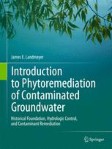Search
Search Results
-
An environmental field assessment of soil quality and phytoremediation of toxic metals from saline soil by selected halophytes
The current study has aims to investigate the soil quality and phytoextraction of cadmium (Cd), chromium (Cr), and lead (Pb) from saline soils using Al...

-
Climate Change Impact on Sundarbans: Challenges for Mitigation Strategies
The Sundarbans, the largest single block of tidal halophytic mangrove forest, has been facing increased challenges due to the combined effects of...
-
Map** Seriphium plumosum encroachment and interaction with wildfire and environmental factors in a protected mountainous grassland
Accurate information on the distribution of invasive native species could provide important and effective procedures for managing savannah...

-
Long-term Water Table Monitoring of Rio Grande Riparian Ecosystems for Restoration Potential Amid Hydroclimatic Challenges
Hydrological processes drive the ecological functioning and sustainability of cottonwood-dominated riparian ecosystems in the arid southwestern USA....

-
Ecohydrology: Processes and Implications for Rangelands
This chapter is organized around the concept of ecohydrological processes that are explicitly tied to ecosystem services. Ecosystem services are...
-
Modulators of mercury risk to wildlife and humans in the context of rapid global change
Environmental mercury (Hg) contamination is an urgent global health threat. The complexity of Hg in the environment can hinder accurate determination...

-
Evaluating revised biomass equations: are some forest types more equivalent than others?
BackgroundIn 2014, Chojnacky et al. published a revised set of biomass equations for trees of temperate US forests, expanding on an existing equation...

-
European Tamaricaceae in Bioengineering on Dry Soils
We tested the bioengineering capabilities and resistance to drought of cuttings of two typical riparian species of Mediterranean and Alpine streams...

-
Inorganic Composition of Saline-Irrigated Biomass
Trace element concentrations on a dry ash basis in saline-irrigated biomass feedstock from the San Joaquin Valley are investigated using...

-
Genetic and environmental influences on leaf phenology and cold hardiness of native and introduced riparian trees
To explore the roles of plasticity and genetic variation in the response to spatial and temporal climate variation, we established a common garden...

-
Plant Selection, Installation, and Management to Affect Groundwater
This quote from the Bible states what, up until recently, was thought to be a long-held observation—that trees growing near streams use surface...
-
Plant and Groundwater Interactions Under Pristine Conditions
An initial understanding of plant and groundwater interactions did not follow a straightforward path. For example, it took many years and...
-
Monitoring for Phytoremediation of Groundwater Contamination
In 1977, the Federal Water Pollution Control Act was amended as the Clean Water Act (CWA). In general, the CWA provides for the regulation of the...
-
Soil Fertility, Salinity and Nematode Diversity Influenced by Tamarix ramosissima in Different Habitats in an Arid Desert Oasis
The aim of this paper was to assess the influence of tamarisk shrubs on soil fertility, salinity and nematode communities in various habitats located...

-
Fundamentals of Plant Anatomy and Physiology Related to Water Use
Water comprises between 75% and 90% of the mass of terrestrial and aquatic plants. Such high water content reflects an aquatic stage during...
-
Ecological risk assessment for water scarcity in China’s Yellow River Delta Wetland
Wetlands are ecologically important due to their hydrologic attributes and their role as ecotones between terrestrial and aquatic ecosystems. Based...

-
Historical Foundation of Plant and Groundwater Interactions
Phytoremediation can be broadly defined as the use of living plants to restore contaminated media to regulatory-mandated levels. Phytoremediation can...
-
Integration of Plant and Groundwater Interactions
The early investigations by plant physiologists who examined the interaction between plants and water were not concerned about the source of the...
-
Fundamentals of Groundwater Hydrogeology
Groundwater composes more than 98% by volume of the available freshwater on earth. Available does not mean readily accessible, however, because more...
-
Monitoring Plant and Groundwater Interactions
In general, the combined processes of evaporation and transpiration can remove about 70% of annual precipitation from a basin or, on a smaller scale,...
